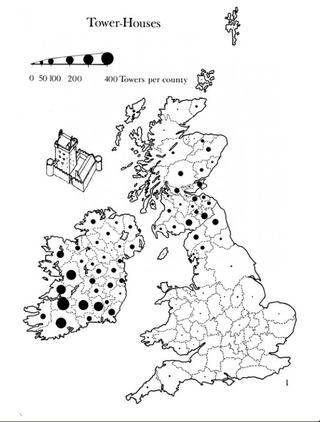
County Longford is a county in Ireland. It is in the province of Leinster. It is named after the town of Longford. Longford County Council is the local authority for the county. The population of the county was 46,634 at the 2022 census. The county is based on the historic Gaelic territory of Annaly (Anghaile), formerly known as Teffia (Teathbha).

William de Burgh, 3rd Earl of Ulster and 4th Baron of Connaught was an Irish noble who was Lieutenant of Ireland (1331) and whose murder, aged 20, led to the Burke Civil War.

Lough Key is a lake in Ireland. It is in the northwest of County Roscommon, northeast of the town of Boyle. The lough is believed to be named after a mythical figure named Cé.

The Conmhaicne were a people of early Ireland, perhaps related to the Laigin, who dispersed to various parts of Ireland. They settled in Connacht and Longford, giving their name to several Conmaicne territories. T. F. O'Rahilly's assertion the Conmaicne were non-Goidelic is not widely accepted.
The Annals of Loch Cé cover events, mainly in Connacht and its neighbouring regions, from 1014 to 1590. It takes its name from Lough Cé in the kingdom of Moylurg - now north County Roscommon - which was the centre of power of the Clan MacDermot. In the sixteenth century, the king Brian MacDermot, commissioned the Annals of Loch Ce, which remain among the most important written records of medieval Irish history. For its earliest centuries it used the Annals of Boyle.

Boyle Abbey is a ruined Cistercian friary located in Boyle, County Roscommon, Ireland. It was founded by Saint Malachy in the 12th century.

Lough Gara is a lake in Counties Sligo and Roscommon, Ireland. It is an Important Bird Area protecting 1,788 ha of which most is covered by a Ramsar Site.
Kenneth Rainsbury Dark is a British archaeologist who works on the 1st millennium AD in Europe and the Roman and Byzantine Middle East, on the archaeology of religion, archaeological theory and methods, and on the relationship between the study of the past and contemporary global political, cultural and economic issues.

Tower houses appeared on the Islands of Ireland and Great Britain starting from the High Middle Ages. They were constructed in the wilder parts of Great Britain and Ireland, particularly in Scotland, and throughout Ireland, until at least up to the 17th century. The remains of such structures are dotted around the Irish and Scottish countryside, with a particular concentration in the Scottish Borders where they include peel towers and bastle houses. Some are still intact and even inhabited today, while others stand as ruined shells.

The Muintir Eolais of Conmaicne Réin, were nobles of Gaelic Ireland. For seven hundred years from the 8th century, they lived and ruled an area roughly conterminous to present-day south County Leitrim. Their territory comprised the lands named Maigh Nissi and Maigh Rein, today the baronies of Leitrim and Mohill respectively.
Galway Castle was a castle located in Galway, County Galway, Ireland.

Holy Trinity Abbey is a former medieval Premonstratensian priory and National Monument located in Lough Key, Ireland.

McDermott's Castle is a castle and protected national monument located in County Roscommon, Ireland. The site of a fortification since at least the 13th century, the structure's tower house may date from the 16th century, with much of the current building dating to the 19th century.
John Bradley was a historian and archaeologist at NUI Maynooth. He grew up in Kilkenny and published many papers about his hometown.

Hilda Elizabeth Jean Le Patourel was a British archaeologist. She specialised in the ceramics and pottery of Yorkshire. She later expanded her field of research to include moated sites and the archaeological remains of dog collars.
Penelope Dransart is an anthropologist, archaeologist, and historian specialising in South American anthropology and the study of castles. Until 2016 she was a Reader at University of Wales Trinity Saint David. She is Honorary Reader at the University of Aberdeen. Dransart was elected as a Fellow of the Society of Antiquaries of London in 1998. She has written or edited several books, including Earth, Water, Fleece and Fabric: An Ethnography and Archaeology of Andean Camelid Herding.
Pamela Marshall is an archaeologist and historian specialising in the study of castles. Marshall was elected as a Fellow of the Society of Antiquaries of London in 2007. She worked at the University of Nottingham, teaching in the departments of archaeology and continuing education until her retirement. Marshall's research on castles has examined castles in England and France, as they had a shared castle culture, and is an authority on great towers. Between 2000 and 2014, Marshall was chair/secretary of the Castle Studies Group and is Comité Permanent of the Colloques Château Gaillard, a biannual conference for castellologists.
Rachel Moss is an Irish art historian and professor specialising in medieval art, with a particular interest in Insular art, medieval Irish Gospel books and monastic history. She is the current head of the Department of the History of Art at Trinity College Dublin, where she was became a fellow in 2022.
Sarah Speight is an academic and Professor of Higher Education at the University of Nottingham. Since 2020, she has been Pro Vice Chancellor for Education and Student Experience and was previously head of the School of Education.
Rachel Swallow is an archaeologist specialising in the study of landscapes and castles. She was elected a Fellow of the Society of Antiquaries of London in 2018. Swallow studied at Birmingham Polytechnic and the University of Liverpool before completing a PhD at the University of Chester in 2015. She is visiting research fellow and guest lecturer at the University of Chester and honorary fellow at the University of Liverpool.










